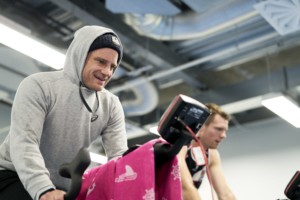- Home
- Research
- Community Health
- Meaningful research being done at the EIT Institute of Sport and Health (EIT ISH)
Meaningful research being done at the EIT Institute of Sport and Health (EIT ISH)

Hockey star, Shea McAleese, uses EIT’s facilities to prepare for Olympics
EIT staff and students have conducted meaningful research at the EIT Institute of Sport and Health (EIT ISH) since it opened its doors in 2019 and the School of Health and Sport Science has made it a goal to increase the community projects undertaken there.
The Institute has been built on the grounds of the Hawke’s Bay Regional Sports Park in Hastings as a venture to enhance community participation in exercise and as a high-performance centre. Run by the Hawke’s Bay Community Fitness Centre Trust, the Institute is used by different groups each week, while EIT also uses teaching facilities and conducts research projects there.
EIT signed a memorandum of understanding with the Trust to collaborate in research project opportunities that arose from their shared interests and areas of expertise. The purpose of this collaboration has been to optimise project outcomes that are meaningful for the region’s communities. The arrangement also saw EIT get naming rights for the Institute.
Dr Ondene van Dulm, who was appointed Head of School, School of Health and Sport Science in September last year, says there are opportunities for EIT, which is always looking to be involved in community-focused research.
She says the Trust may share an interest in research data from projects being done by EIT’s degree students and may contribute their own.
“For example, our first-year students spend a number of weeks in primary schools doing programmes with the children. It may be teaching them new games, or fitness, but each project group comes up with their own proposal and study.”
“It’s the perfect opportunity to say: ‘Okay, what data can we gather there?’”
Ondene says this could be simple things like asking participants questions about their attitudes and feelings about exercise, measuring their heart rate and other indicators and monitoring changes over time.
“If we’re doing it in our school-based projects, then the Trust could potentially do it in their school-based programmes as well, which means we get to increase our data.”
“As soon as you’re studying something in more than one context, then you’ve got that possibility of expanding it to include more things and make comparisons.”
One such collaborative project is seeing EIT researchers Lee-Anne Taylor, Dr Patrick Lander and Dr Russell Rayner working with Hawke’s Bay Community Fitness Centre Trust researchers Joshua Stewart and Kendall Malcom on a study called Youth athlete and training workload.
The project entails multi-phase research investigating youth athlete training loads. It will examine the knowledge of athletes, coaches, and parents regarding training loads, load management, and youth athletes’ wellbeing.
The intention of this project is to inform best practice with evidence-based information to enhance youth athlete development within the Hawke’s Bay region and New Zealand.
Ondene says collaboration such as this with the community, students and other interested parties is important, but needs to be done in a way that maximises EIT’s opportunities for external funding grants.
Funding is always an issue as there is a lot of competition from other tertiary institutes and organisations. Ondene believes that while it is important for her School to continue with individual research projects focused on sport performance, community-centred studies like youth wellbeing or common issues like obesity, may offer greater opportunities for external funding.
“The more people and parties you can involve in a project, and the more likely you are to achieve valuable community outcomes, the more likely you are to attract funding.”
Meanwhile, Ondene says there are opportunities for postgraduate research at the ISH, with two Master of Health Science students, Liz McKay and Ormond Heather working on projects there.
Liz is examining the use of a Rock-it Board device(a wooden balance board) to improve strength and balance in older adults. This study will investigate the effectiveness of a Rock-it Board training programme for developing strength and balance to help prevent falls in an older population.
Ormond is investigating the relationship between force-velocity profiles and exercise orientation with post-contact metres. This study will endeavour to identify the optimal training parameters to increase post-contact metres in semi-elite rugby players.
Apart from its involvement at the regional sports park EIT also has a relationship with Sport Hawke’s Bay and the Pettigrew Green Arena (PGA), which is across the road from the Taradale campus.
Ondene admits that there is some crossover in facilities at the different venues, but this is an opportunity for further collaboration.
“So, we’d like to keep both the Hawke’s Bay Community Fitness Centre Trust and Sport Hawke’s Bay involved in student projects and their industry projects, as well as our own research.”
“There is a lot of scope that hasn’t yet been tapped. For example, we have labs at PGA and the Sports Park with some equipment that is the same and some that is different.”
A sport science services technician, Dr Philip Shambrook, has recently been hired to maximise the use of this range of equipment at the two labs, as well as using mobile equipment in the field.
“Community research is what we do best, and we want to use everything at our disposal to carry out effective and meaningful research for our communities,” says Ondene.
